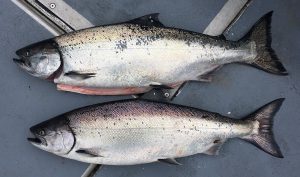West Coast Ocean Salmon Season: Options Open for Public Review
 The Pacific Fishery Management Council (Council) has crafted three options for 2024 ocean salmon fisheries along the coasts of Washington, Oregon, and California, now open for public assessment. A final verdict on salmon seasons should be reached during the Council’s upcoming meeting scheduled for April 6-11, 2024, in Seattle, WA. Extensive details regarding starting dates, open areas, and catch limits for the three options can be found on the Council’s website at www.pcouncil.org .
The Pacific Fishery Management Council (Council) has crafted three options for 2024 ocean salmon fisheries along the coasts of Washington, Oregon, and California, now open for public assessment. A final verdict on salmon seasons should be reached during the Council’s upcoming meeting scheduled for April 6-11, 2024, in Seattle, WA. Extensive details regarding starting dates, open areas, and catch limits for the three options can be found on the Council’s website at www.pcouncil.org .
The projections for West Coast Chinook and coho stocks in 2024 present a varied outlook, encompassing both declines and increases compared to the previous year. Primary constraints for this year’s ocean salmon fisheries will be the federal mandates aimed at conserving Fraser River (Canada) coho, Washington coast natural coho, lower Columbia River natural coho, Klamath River fall Chinook, and Sacramento River fall Chinook populations.
“Meeting our conservation and management objectives continues to be the highest priority for the Council,” said Council Chair, Brad Pettinger. “Balancing those objectives while providing meaningful commercial and recreational seasons remains a challenge in 2024.”
- Ocean troll season alternatives are here.
- Ocean tribal season alternatives are here.
- General salmon season information is here.
“The 2024 salmon season discussions have once again been dominated by the severely low forecasts for both the Klamath and Sacramento River fall Chinook stocks”, said Executive Director, Merrick Burden, “the Council will need to do its best when setting the 2024 seasons to include considerations for the economic implications to the coastal communities and the low abundances of key salmon stocks.”
The Council collaborated closely with the National Marine Fisheries Service (NMFS) to assess the impact of Council-area fisheries on the endangered Southern Resident killer whales. Drawing on insights from the Council’s ad-hoc Southern Resident Killer Whale Workgroup, amendments were made to the Pacific Salmon Fishery Management Plan. These amendments aimed to accommodate the needs of the whales while still allowing for salmon harvest opportunities. One notable change was the adoption of a Chinook abundance threshold for the North of Falcon area. The established threshold stands at 623,000 Chinook. If Chinook abundance falls below this threshold, additional management measures will be implemented when determining ocean salmon seasons.
The Council has arranged one public hearing in each coastal state to gather feedback on the alternatives. In-person hearings for Washington and California are set for Monday, March 25, while the Oregon hearing will be held online on Tuesday, March 26. Additionally, the public can provide comments on the alternatives during the April Council meeting. Instructions and materials for participating in online Council meetings and hearings will be available on the Council website.
The Council will engage in conversations with scientists, consider public feedback, and ultimately select a course of action during its meeting scheduled for April 6-11. Subsequently, the Council will forward seasonal recommendations to NMFS for endorsement and execution by May 16, 2024. It is important to note that all Council sessions are open to the public.
The Magnuson Fishery Conservation and Management Act of 1976 established the Pacific Fishery Management Council as one of eight regional councils tasked with managing fisheries spanning from 3 to 200 miles off the U.S. coastline. Specifically, the Pacific Council advises on management strategies for fisheries along the coasts of California, Oregon, and Washington.
 Maritime Injury Law Blog
Maritime Injury Law Blog

